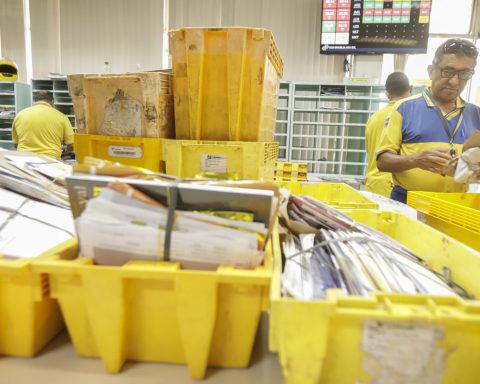María Mena M. / Cochabamba
“It was a harrowing night. We do not sleep taking care that the water does not enter our house ”. Francisco Sarmiento does not forget the early morning of December 15 when the storm did not cease for hours. His family lives on Calle San Marcos, in the Don Bosco neighborhood, a few meters from the Tamborada River, south of the city of Cochabamba. Every year in the rainy season, they have to deal with the anxiety of the river overflowing its banks or the sewers and drains collapsing, flooding their home and that of their neighbors.
The picture is similar throughout that sector. Every year history repeats itself. Streets and avenues flooded after the collapse of the sewers and drains, especially in the Panamericana avenue and the Tamborada bridge. There, the cloudy water exceeds half a meter in height, making it impossible for vehicles and pedestrians to circulate.
The southern zone is a clear example of the lessons not learned by municipal and departmental authorities, by neighbors and leaders after the repeated disasters caused by the rains. The victims of the floods and the authorities identify as causes of this recurrence the lack of provisions, contingency plans, cleaning of the sewers and drains, and the exploitation of aggregates that cause the rains in La Llajta.
In early December, the Vice Minister of Civil Defense, Juan Carlos Calvimontes, reported that the departments most affected by the rains were Cochabamba and La Paz. Since then the situation has worsened in both regions.
“Due to the cost of human lives (the most affected) is the department of La Paz, in the municipality of Mapiri, but due to the severity of the damage caused it is the department of Cochabamba, especially in the municipality of Cliza,” he declared in the national report on rains.
No plans or resources
“The Government presented us (2017 – 2018) a contingency plan to make forecasts on climate change. The plan was very good, it proposed dredging and construction of defenses so that the rivers do not overflow, but it was not fulfilled. The Ministry of Defense should transfer more resources to the Government so that it can in turn distribute it to the municipalities so that they face disasters, “says the general manager of the Agricultural Chamber of Cochabamba (CAC), Rolando Morales.
The Secretary of Mother Earth of the Government of Cochabamba, Maricela Rodríguez, identifies other causes by which the rains originate a series of disasters that could be prevented in the department.
“We have had irrigation canals overflowing. It is due to the issue of garbage, they do not clean or open the drains on time, so it overflows and affects families. There is also the fact that the municipalities have not taken the necessary provisions and did not clean the rivers or drains at the time. In addition, the uncontrolled exploitation of aggregates and aggregates that ends up obstructing the natural course of the rivers ”, explains the official.
Hail and floods
The Secretariat of Mother Earth of the Cochabamba Government identifies at least nine municipalities affected by floods, hailstorms, electrical storms, floods and others in this rainy season. The most affected are Cercado, Tiquipaya, Colcapirhua, Vinto, Cliza and Arque.
The heavy rain that fell on the night of December 15-16 caused the Llicani River to overflow its banks, to the extreme south of the city of Cochabamba. Corn and alfalfa plantations were flooded and 15 hectares of 10 families were affected.
In the city center, heavy rains collapsed the sewage system and drains and flooded streets and avenues in at least ten conflictive areas or sectors identified by the Mayor’s Office. Municipal personnel still carry out cleaning and dredging work so that there is better water circulation. Likewise, a week ago an intense hailstorm fell in the municipalities of Quillacollo, Sipe Sipe and Vinto, damaging 45 hectares of flowers and vegetables for approximately 1,500 families that live on these crops.
In Vinto, a flood collapsed six houses and affected 100 houses, damaging crops in the area. The Mayor’s Office is analyzing declaring itself in a disaster zone to allocate economic resources to help mitigate the damage.
“In the Alto Valley, in Cliza, several houses have fallen and due to the floods, more than 200 hectares of vegetable, vegetable and fruit production have been lost. In the Lower Valley we have had a tremendous hailstorm that affected 45 hectares of flower production and 75% is irrecoverable. The damaged flowers are chrysanthemums and gladioli. We have also had the report of the vegetable producers because the Vinto river has overflowed ”, affirms Morales.
Photo: Comunarios Arque
On December 8, the Arque river overflowed and affected the municipalities of Arque and Sicaya. Farmers lost their crops, their homes, and their livestock.
Only in the Andean region there are more than 1,300 families and more than 340 thousand hectares of crops affected by floods and hailstorms in 65 communities of Arque, Tapacarí, Sicaya, Bolívar and Tacopaya. The crops most affected are corn, vegetables, broad beans, peas and potatoes.
“We have already collected urea for the agricultural sector and distribution is being made to the affected families. Seeds are also being provided. In Arque they even arrived with beds, pots and other supplies because the people have lost everything, ”reported the manager of the community, Franulic Huanca.
The rain on December 16 caused the collapse of a road in the municipality of Bolívar and left that Andean region isolated. The Mayor’s Office displaces heavy machinery to prepare the road.
Risk in Tiquipaya

Photo: Community of Tiquipaya
In Tiquipaya, the risk of the overflow of the Taquiña basin continues due to the floods in recent days. The Vice Minister of Civil Defense, Juan Carlos Calvimontes, warned that the threat will remain latent as long as the illegal constructions or settlements on the river banks persist.
Meanwhile, the Mayor’s Office of said municipality and the Governor’s Office are undertaking dredging and cleaning work to prevent major disasters with the loss of human life, as occurred in 2018, after a flood that flooded several homes.
According to Morales, despite the heavy rains, the Cochabamba tropics did not record the overflowing of rivers or the loss of crops as in other years, although he warns that the threat is latent.
The official website of the National Meteorology and Hydrology Service issued an alert in different basins of the country. In Cochabamba there is a risk of overflowing the upper basin of the Mamoré river, affecting the Ichilo, Ivirgarzama, Chimoré, Chipiriri, Eterazama and Ichoa rivers of the Cochabamba tropics. Also to the Mizque river and other secondary tributaries.
Affected regions
-
Municipalities The municipalities of Cochabamba most affected by natural disasters are: Cercado, Colcapirhua, Tiquipaya, Quillacollo, Sacaba, Arque and Tolata.
-
Landslides In the Bolívar-Tapacarí section, a collapse due to heavy rains caused the road to be cut off.
-
Taquiña In Tiquipaya, the risk of the Taquiña basin overflowing due to the floods continues.
-
Alert Ten points of high risk of flooding were identified in Cochabamba by the Mayor’s Office.
340,000
hectares were lost due to
hailstorms and floods
that affect the valluna region.

Photo: APG
The Taquiña River threatens again with floods in Tiquipaya
“The tubing we have for the water has been taken by the entire Taquiña River. That is why we are without drinking water for two weeks. No authority has been able to cooperate with us to restore drinking water service. Furthermore, the machinery that works in the river prevents the water from crystallizing so that we can consume it ”, laments the executive secretary of the Taquiña Agrarian Union, Ricardo Pelaes.
The leader assures that while the Taquiña basin overflows because of the rains, there will be a risk that it will flood their homes and crops, affecting the drinking water connections.
The northern area of the Taquiña basin is characterized by the fact that its inhabitants are dedicated to the cultivation of different products, especially flowers. They produce onion, cucumber, pod, potato, corn, lettuce, orange, lemon and others. The flowers must be watered with potable water or they will spoil.
Farmers in the area own 80 cultivable hectares, of which 20 hectares were affected by water scarcity. Its main marketing market is Calatayud.
“There was a hailstorm in Tirani that damaged crops, but not to a great extent. Even so, nurseries have been destroyed by the weight of the hail. Some vegetables were also lost, such as potatoes, ”says Pelaes.
Disasters in Tiquipaya
On February 6, 2018, the heavy rains in the municipality of Tiquipaya caused a flood of great magnitude that affected the inhabitants near the Taquiña River. That disaster killed five people, including a minor, and buried more than 15 homes.
In 2020 another barrage, of less impact, affected homes and generated panic among its inhabitants.
More than three years after the first disaster, the Government of Cochabamba and the Mayor’s Office of Tiquipaya continue with the works and prevention works to prevent another tragedy of a similar magnitude from being repeated.
The rains in November and December have increased the flow of the Taquiña basin, activating the alarms in the municipalities of Cercado and Tiquipaya. There is heavy machinery displaced in the sector. (MMM).


















